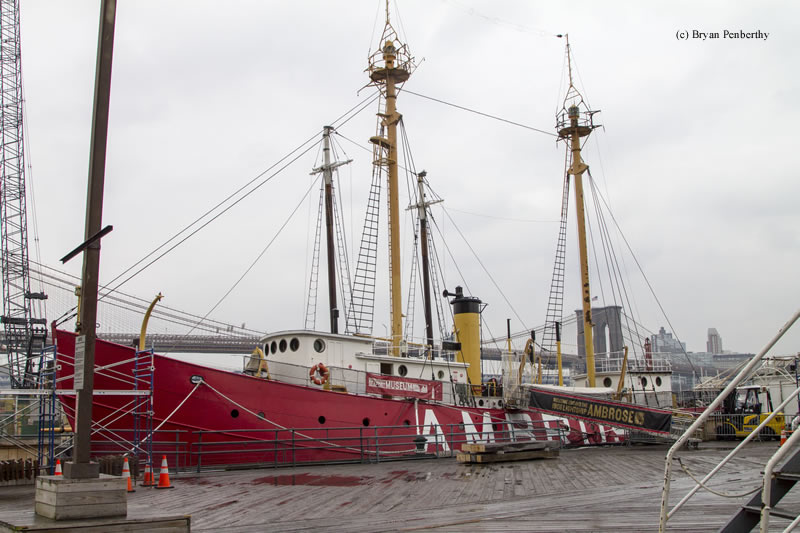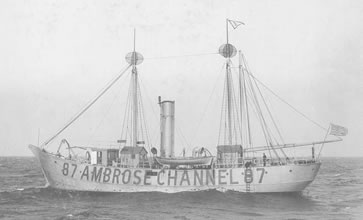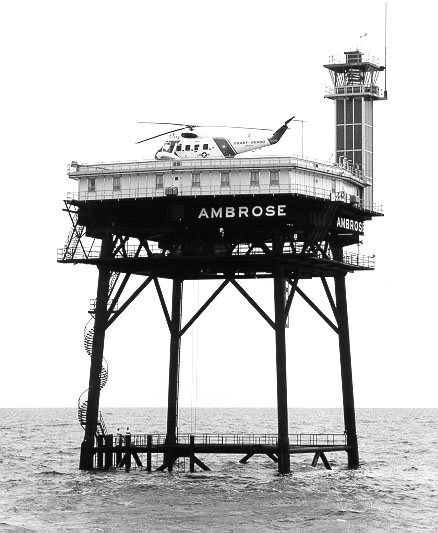Ambrose Lightship (LV-87/WAL-512)
New York, New York - 1907 (1823**)

History of the Ambrose Lightship (LV-87/WAL-512)
Posted/Updated by Bryan Penberthy on 2015-08-19.
The main shipping channel into and out of the Port of New York and New Jersey is known as the Ambrose Channel. The channel starts several miles off the coast of Sandy Hook, New Jersey and was marked by the Ambrose Lightship, later replaced by the Ambrose Tower in 1967.
The channel is named after the late John Wolfe Ambrose, an Irish immigrant that came to New York at a young age. After college, Ambrose became involved in large-scale construction projects around New York City.
During the 1880s, Ambrose focused his attention on the Brooklyn waterfront and its development. Through his companies, he became aware of the inadequacies of the channels of the Port of New York. With that, he spent much of his time lobbying Congress for improvements to New York Harbor.
Over the years John Ambrose's work resulted in more than $8 million being appropriated to improve the harbor. His final act took place in April of 1899 when he advocated for a channel 2,000 feet wide and 45-foot-deep to be dredged from the narrows to the ocean.
On May 15, 1899, John Ambrose passed away before his vision could be realized. Later that year, Congress would appropriate $4 million for the work. Congress, in honor of all Mr. Ambrose done passed a bill in 1901 naming the channel that he had worked tirelessly on, the Ambrose Channel.
Before any lightships would be called "Ambrose," the first ship stationed at the southern edge of the Ambrose Channel was called "SANDY HOOK" due to its relation to Sandy Hook, New Jersey.
Over the years, many lightships would mark the channel. The first such ship to mark "SANDY HOOK" was the lightship "VV" in 1823. It would serve for six years until the station's decommissioning in 1829. No lightship would mark the channel for the next nine years.
In 1839, the station would be reestablished with Lightship "WW." Outfitted with two 4-sided lanterns, it was said to be visible for four miles under ordinary conditions. This vessel would serve "SANDY HOOK" (Ambrose Channel) until 1854.
LV-16 would take over the location in 1854. On February 15, 1873, the light color was changed from white to red. A year later, the vessel was involved in a collision with the steamer Charleston.
By 1883, LV-16 was listed as "decayed and unserviceable" in the Annual Report of the Lighthouse Board. On September 15, the vessel was pulled from her station and taken to New Bedford, Massachusetts to be overhauled and repaired.On May 2, 1888, while heading out of New York Harbor, the British bark Star of the East ran into LV-16 severely damaging it. It would be repaired and placed back into service later that year, continuing on the SANDY HOOK post until 1891.
On August 1, 1891, LV-16 was replaced by LV-48. The new vessel would continue to carry the "SANDY HOOK" name on its side and would only serve for a few years before being removed in December 1894. LV-48 would later be placed at Cornfield Point, Connecticut in January of 1895.
LV-51, the first U.S. lightship with an electric illuminating apparatus was withdrawn from Cornfield Point on December 6, 1894 and placed off Sandy Hook soon thereafter. The reason for the change was to get a light vessel with the more efficient electric lights at the entrance to New York Harbor, which was deemed an important station.
When LV-48 marked the Ambrose Channel, its characteristic was a flashing red light every 30 seconds from the foremast and fixed red from the mainmast. When replaced by LV-51, its new characteristic was a fixed white electric light shown from the mainmast for a period of 12 seconds, separated by an eclipse of 3 seconds.

LV-87 / WAL-512 (Ambrose Lightship)
This new characteristic provided a distinction from the many other lights in the area and was reported by some mariners that they were able to pick up LV-51's light ten minutes after spotting the Navesink Light in Highlands of New Jersey. This also allowed the Scotland Light Vessel to be changed to a fixed red light, allowing to the two vessels to be unique.
LV-51 would serve the Ambrose Channel until 1908 when it was replaced by LV-87/WAL-512. At this time, the Sandy Hook lightship station was moved to eight miles east of Rockaway Point and given the name "AMBROSE." LV-87/WAL-512 would be the first lightship to carry the "AMBROSE" name on its side.
The New York Shipbuilding Company of Camden, New Jersey built LV-87/WAL-512 in 1907 for $99,000. When originally constructed, it was outfitted with a cluster of three oil lens lanterns on each masthead, a 12" steam whistle chime, and as a backup, a hand-operated fog bell.
Within a year, the lighting apparatus was upgraded to more efficient electric incandescent lights. Staten Island resident, Gustav A. Lange was the first master of the vessel. He would serve in this capacity until 1932.
During his tenure, Lange called out two notable incidents. The first incident took place on September 14, 1914 while Lange was ashore. A tug pulled up alongside the lightship to drop off newspapers and a letter for the Essex, a British warship.
After a brief period, a boat from the Essex arrived to retrieve the letter. When Lange returned, he notified his superiors on what took place at which time he was advised that the actions of the crew could be viewed as a breach of the nation's neutrality as the United States hadn't been pulled into World War I at that time. The U.S. would enter World War I three years later, in 1917.
The other notable incident took place on February 20, 1927 when Lange and his crew would ride out a fierce gale. Winds were recorded at force 9 (48-56 mph) with waves as greater than 20 feet. His entry in the ship's log contained such language as "Snowy NE gales with hail and snow," and "At 10:30 am, seas broke over mid-ship."
After pitching wildly at its mooring, it finally broke free and drifted off station. After starting the engine, Lange radioed the incident in and headed to the Lighthouse Depot on Staten Island. It would be a week before the Ambrose would return to its post.

Ambrose Light Tower (Courtesy Coast Guard)
When it was replaced by LV-111/WAL-533 in 1932, LV-87/WAL-512 was reassigned as a relief vessel. It would serve in the "RELIEF" capacity for four years before being reassigned as the Scotland Lightship.
LV-111/WAL-533 served the Ambrose post until August of 1952. A relief vessel took over until October of that year when WLV-613 had arrived. WLV-613 would be the last lightship to mark the Ambrose Channel serving until August 23, 1967.
Lightship WLV-613 was replaced by a $2.5 million "Texas" tower, which resembled an oil-drilling platform. Four legs driven 245 feet into bedrock supported the structure and it was said to withstand winds in excess of 125 knots and 65-foot waves.
The light of the Ambrose Tower was 90 feet above the water's surface, had a focal plane of 136 feet, and its 10-million-candlepower light was visible for 18 miles.
A light tower in the middle of a shipping channel leading to a busy port was a dangerous proposition and was struck on numerous occasions.
In 1996, the Ambrose Tower was struck by a Greek oil tanker Aegeo, although it was repaired, it was later deemed that the repairs were insufficient and it was razed in 1999.
A new 70-foot Ambrose Tower was erected in 1999. In November of 2007, the 799-foot tanker Axel Spirit struck the new tower rendering it inoperable. It was soon torn down, to be replaced by a buoy.
Today, LV-87/WAL-512 is docked at the South Street Seaport Museum in Manhattan. The lightship is open seasonally to visitors from late spring until fall.
Reference:
- Northeast Lights - Lighthouses and Lightships, Robert G. Bachand, 1989.
- Annual Report of the Light House Board, U.S. Lighthouse Service, Various years.
- "Ambrose Light, deemed obsolete, passes into history," Dom Yanchunas, Professional Mariner, November 24, 2008.
- Wikipedia.com website.
- U.S. Coast Guard website.
Directions: LV-87/WAL-512 is docked at the South Street Seaport Museum in Manhattan. The museum is located at Fulton and South Streets in Lower Manhattan.
Access: The lightship is owned by the South Street Seaport Museum. Grounds open year round, lightship open seasonally.
View more Ambrose Lightship (LV-87/WAL-512) picturesTower Height: Unknown
Focal Plane: Unknown
Active Aid to Navigation: Deactivated (2007)
*Latitude: 40.70500 N
*Longitude: -74.00200 W
See this lighthouse on Google Maps.
